
BILL'S
[Somewhat] WEEKLY COLUMN/BLOG PAGE

That Couldn't Happen Today
I don't know where, but I have heard the statement, “You sure couldn't do that today !” somewhere before.
Nowhere is that more true than in the world of racing. With the way things are today, what with uniformity, even playing fields, cookie cutter equipment, and such – there isn't much room for anything out of the ordinary. {And, if there appears such a thing, it is quickly extinguished or otherwise summarily disposed of].
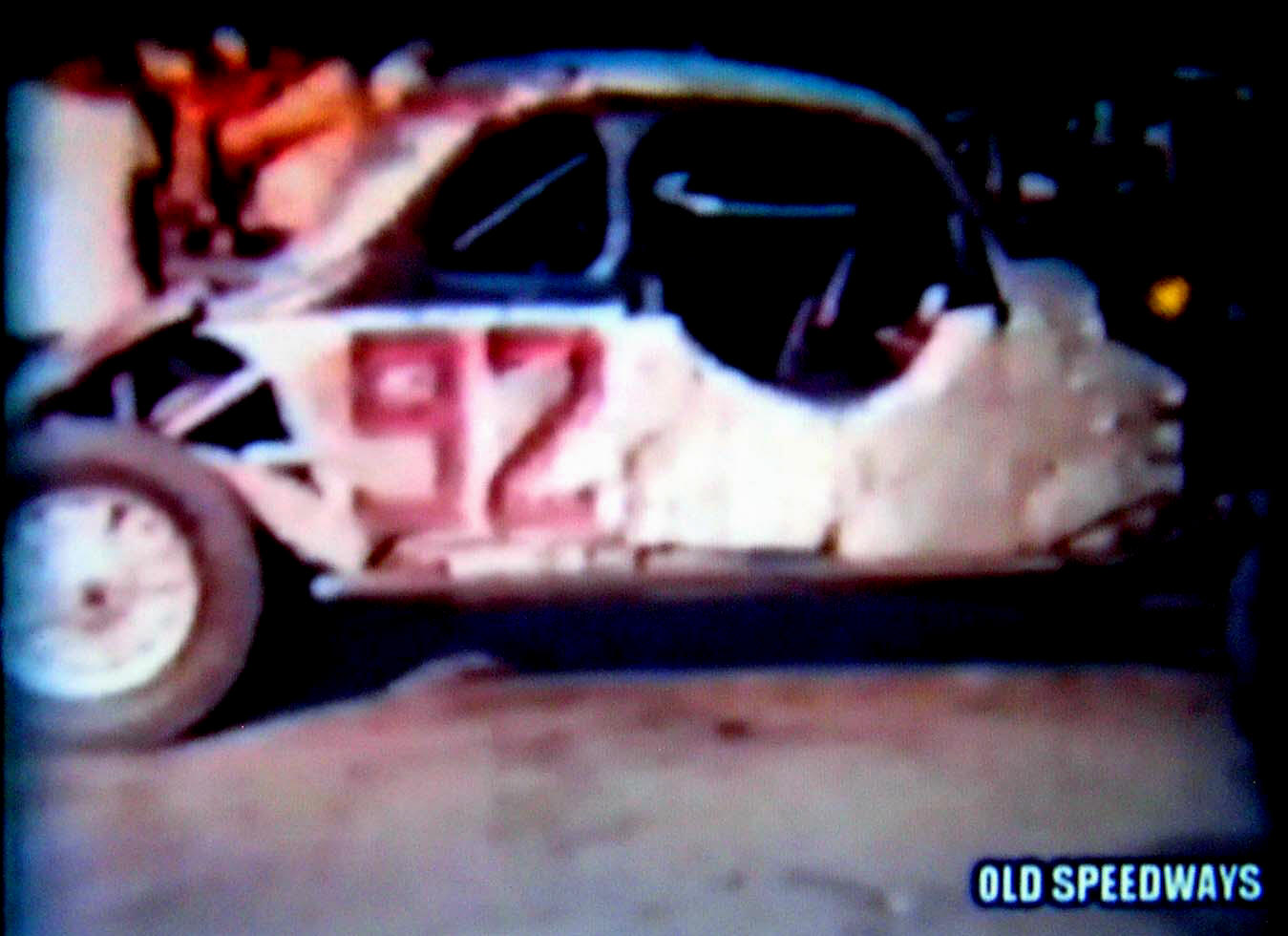
From Dan Odys's 8MM Old Speedways DVD's
This could never happen
today, that's for sure. A sort of
cutdown type car at Brattleboro Speedway in the 1950's.
One case in point is evidenced by the specialization seen in most racing today. Those years which culminated with the All Star League of Stock Car Racing had a number of stock car racing's top stars who could often take the same car and make it really good on wither pavement or dirt tracks. Even the behemoth Grand National cars had to run on both – in the days that ended when the Grand National Northern tour stopped in the early '70's.
I have to be honest, there are some guys up my way, such as Vince Quenneville, Jr., Billy Lussier, Cody Aubin and others who ran both of Devil's Bowl's track [which had both surfaces until the 2018 season]. I read where some tracks, such as Kempton Park Speedway in the Montreal area, had turns and stretches made of different surface materials. In the case of Kempton Park, the stretches were paved and the corners – dirt [or terre battue, as they called it up there].
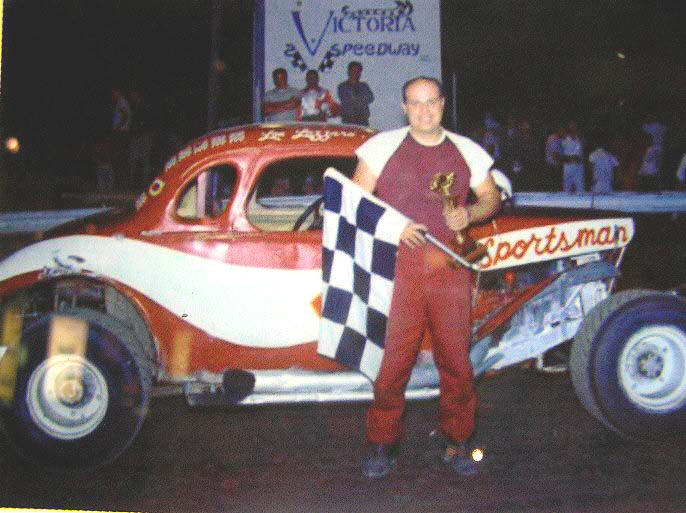
Russ Bergh Photo via Lazaaro Family
Lou Lazzaro could take the
same car and be just as
unbeatable on dirt at Victoria or on pavement at
Malta. Below – Will Cagle, along with Lazzaro,
Narducci, and others, was great in the All Star
League because of his versatility. He is seen here at
a Catamount ASL show.
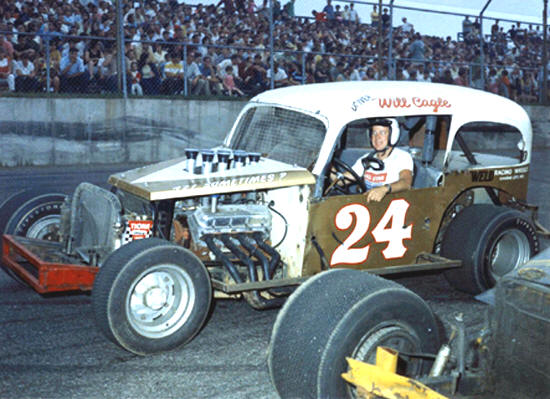
Ladabouche Collection
I also think the Pine Bowl Speedway, in the Troy, NY area was another that – for a while – had the two areas made of different materials. Then there was a track whose name I can't recall which had asphalt in one area and cement in the other. The way cars are constructed today, I doubt they would perform very happily on any of these old tracks. Of course, if everyone there was equally uncomfortable, I guess I guess it would fly.
Another thing that would probably not fly today is the way Catamount Stadium used to handle its weekly proceeds. Today, very little banking related business is done unless it involves the internet. Catamount was just old enough to have not existed in the computer age much at all. Now, the way the story goes, when the track first opened, the neighboring Sibley family, whose property abutted the track, had a big tree house in the back yard and the boys would get to see racing free.
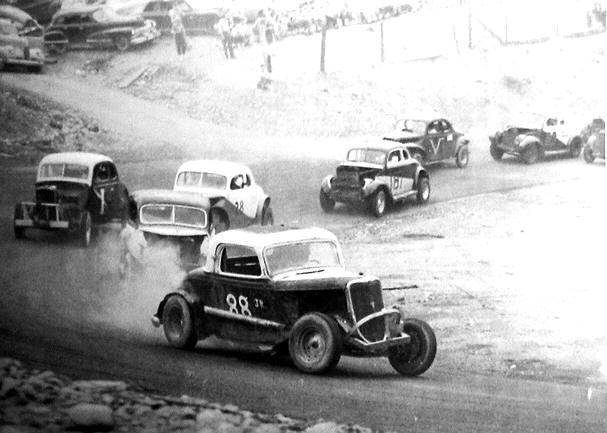
Source Unknown
This shot of Pine Bowl
action, including Stan Disbrow's V, doesn't
offer a hint as to whether the track has two surfaces or one here.
Below - This shot of an early Flying Tiger field at Catamount clearly
shows the infamous Sibley treehouse and how vulnerably
it was located.
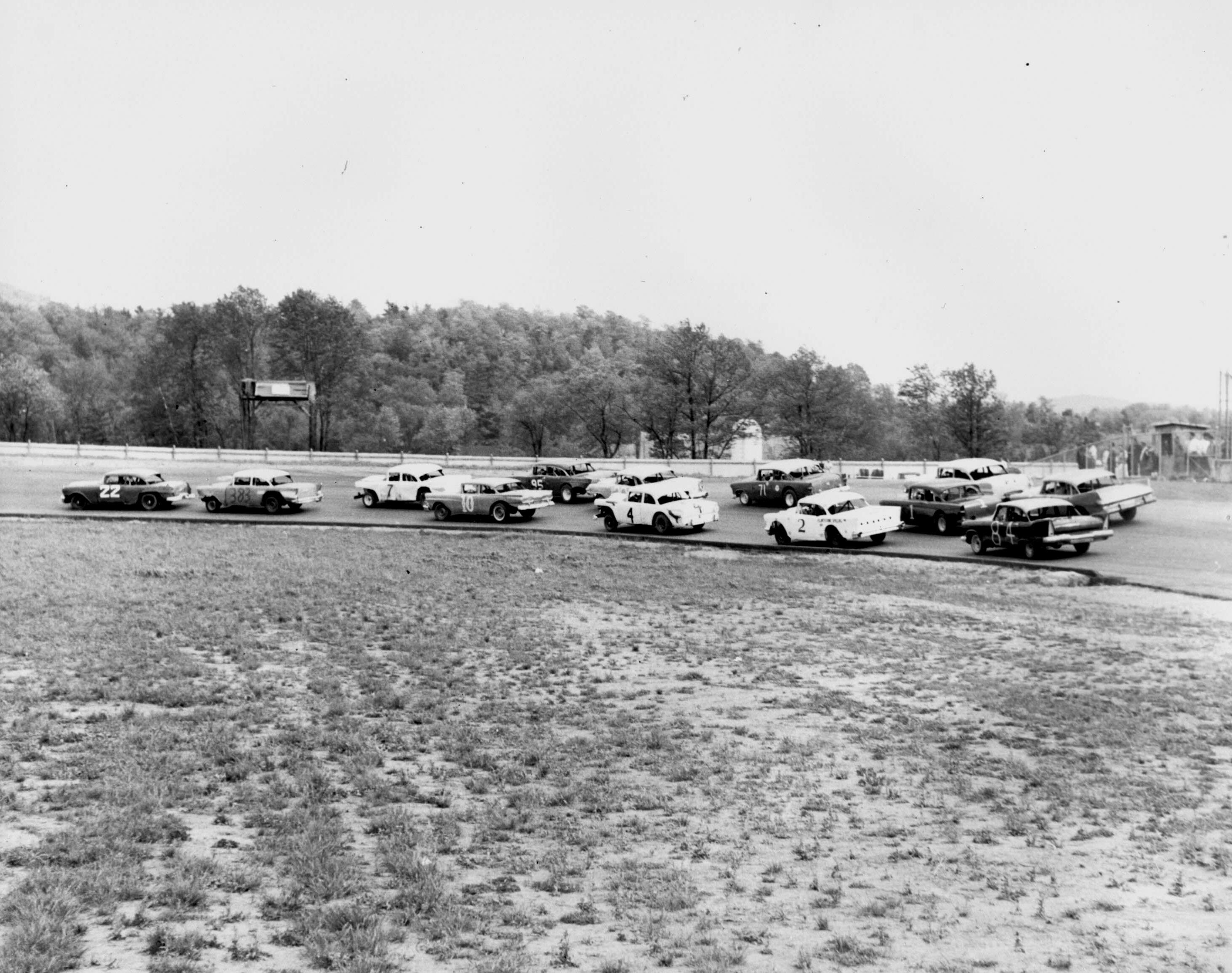
Courtesy of Cho Lee
According to Ken Squier, the insurance company told the track it would refuse to cover the track if the tree house didn't go. Squier and Dubrul scratched their heads because the tree house was not on Catamount land. Finally, according to Ray Sibley, they were approached with the deal that they could have good jobs at the track if they would discontinue using the outdoor penthouse. After all, they had nearly been knocked out of the tree once when it was struck by the sportsman coupe of Marcel Godard.
Ray Tells me he ended up handling Catamount money after the races. Firstly, he says a lot of the money [U.S. Currency, in this case] was lugged off to the Merchants Bank in garbage bags. Imagine that today, unless you're dealing in something much more noteworthy than track receipts. But the Canadian money was even better.
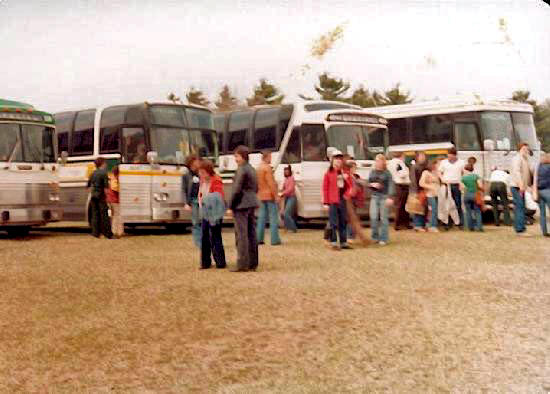
Denis LaChance Photo
Busloads of Canadians
dismbark at Catamount during the height of
the track's popularity in Quebec. Below – Canadian Jean – Paul Cabana's
presence, as well as dozens of other top countrymen at Catamount
made for huge Canadian attendance. Poetically, JPC won both the
first ever and final features at Catamount. This was his first.

Courtesy of Cho Lee
Jean – Paul Cabana once told me that often, Canadians made up nearly 50% of the spectators at the well – attended track which was located just off Interstate 89 – about 30 minutes from the border. Sibley pointed out that laws dictated that only $10,000 or less could be brought across the border to be exchanged at one time [and that time was a considerably large stretch of time, like a week].
Catamount Stadium would, on any given week, have about 20 to 30 thousand dollars in Canadian currency to deal with. Considering that the laws did not allow for another vehicle to bring more of the money across within that time period, they had to do something. Sibley smiles when he says he'd show up the border every week in a pickup truck and $10,000 in the cab. What no one checked was a rusty, dented old tool box sitting in plain sight in the box of the pickup. It would have $20 to $30,000 in there every week. Try that today !
Ladabouche Collection
The Bob Dragon 71 team
braintrust by the 1970's when he had
returned to Catamount from a self – imposed exile to Devil's Bowl.
Included [fron left]: Frankie Woodard, Billy Tower, Gary Desranleau,
Veronica Desranleau Dragon, John Keefer, Steve Hibbard,
and Bobby Clark. Below – The Allison Chevelle, early on in
its unbelievable run of success.

Courtesy of Steve Pecor
Another situation concerning moolah is probably just not possible anymore or less likely anyway]. At last summer's get – together for the Milton [VT] Historical Society's wonderful programs on the history of racing in the town, Bob Dragon, John Keefer, and other members of their hugely successful racing team spoke. After starting out with low dollar Flying Tiger equipment [NASCAR hobby class cars], Dragon and his circle had thrown in with Northern NASCAR's new late model sportsman circuit that began, in earnest, in 1972.
Even as early as 1969, Keefer [ a motor specialist who was involved in drag racing] had thrown in with the Dragon 71 team. John says each man contributed about $200 at the time. Neither John nor Bob Dragon are men given to exaggeration or lies; they both claim that they never again had to put their own money in a race effort that set many records for success. The team went down South and came back with a '65 Chevelle with an Allison chassis for the '72 season. Bob says that, at the time, this put them technically ahead of most of the other teams on a very competitive circuit.
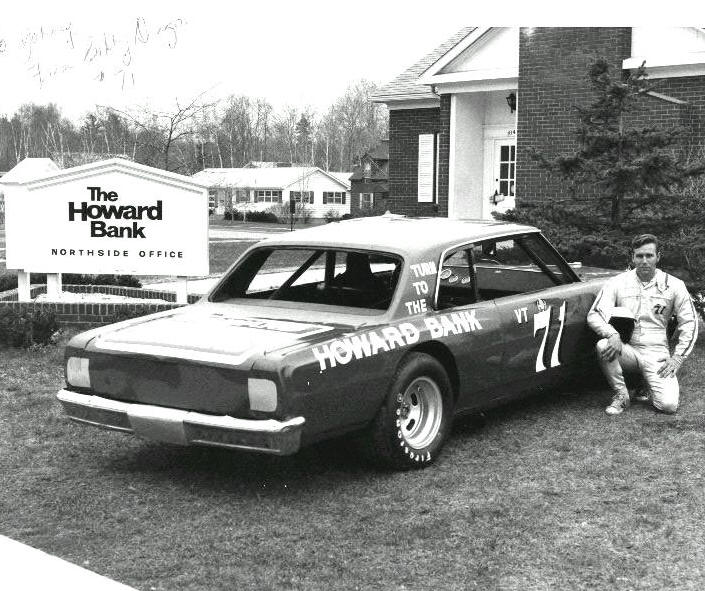
Source Unknown
Dragon's team landed the
great Howard Bank deal by 1973
but even that could not completely guarantee weathering
the psychotic 1973 Northern NASCAR schedule of that year.
Check out the car here, on Friday night at Airborne.
Courtesy of Dave Brown
They won about 22 features in one season and 26 the next, and ended up gaining a great sponsorship from the Howard Bank. No matter what after that, the team always took in enough winnings or sponsorship to keep things going on a high level and no one ever had to toss money into the pot again. Eventually, another man took over ownership. In this day and age, with all the expense and the small payouts, I doubt this would ever happen. Of course, this is closely related to those stories of guys like Ernie Gahan traveling around and making a living with just short track racing.
Joe Thomas, this past summer, also had a similar story from the 1970's. He had run pavement modified racing for car owner Jimmy Guynup at tracks like Airborne and Devil's Bowl with a #37 coupe and a decent Budweiser sponsorship. Joe says, at one point, he bought the car from famed car owner Vic Wolfe and then found the Bud support. He said they started out strong – winning a couple and placing well in a couple more races. He says these four races completely paid for the car. Don't think that could happen today in any lead division.
Bob Mackey Photo via Mike Watts Sr.
Joe Thomas and the
financially – successful modified coupe
he and Jimmy Guynup got from Vic Wolfe. Below - Hector
LeClaire, with an earlier sponsorship, Bug Ben Pizza.
Ladabouche Photo
Today, there is tremendous need for sponsorship and a lot of competition to land
it. Today's cars ware covered with ads, but most of them aren't very large.
Then, too, tracks need to sell every night of racing to a sponsor just to stay
afloat. Back in the '70's and early '80's – it wasn't quite so desperate and the
somewhat autocratic State of Vermont sometimes got in the way. These were the
years of the Beer Tours. Hector LeClaire, talking at the same get together as
the Dragon folks, tells of how he landed a beaut of a sponsorship one year from
Budweiser. He says that a Vermont State Liquor inspector took umbrage with the
big splash LEClaire was making with Bud the car. He stated the car was “a moving
billboard [and billboards are banned in Vermont]. Hector lost the deal.
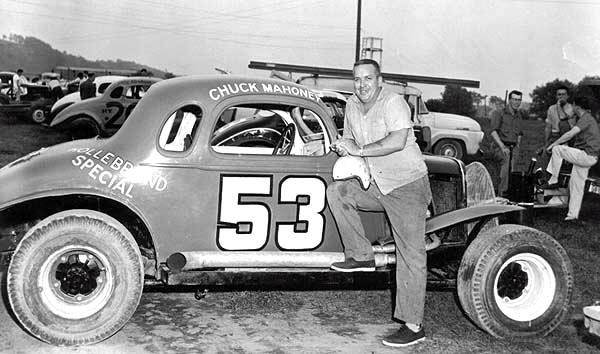
Courtesy of Jo Towns via Otto Graham
Strong personality Chuck
Mahoney with that same
Hollebrand coupe he was running at Syracuse. Below -
Fred Decar with the McCredy 33 – then Wimble's.
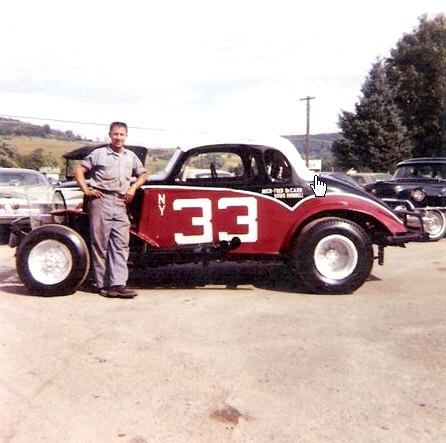
Decar Collection
The next thing that would never happen today was – well, Chuck Mahoney. An outrageous personality in the early days of racing, Chuck, from the Rochester, NY area, made it as far as NASCAR's big leagues -the Grand Nationals; but, he was a total character. Today there isn't much work for someone who quite that much force of personality. Mahoney, whose most famous photo is arguably one in which he is running a race on three wheels, could be a little hard to digest at times.
For a while, Chuck was running for the well – heeled Dave McCredy S33 team that eventually became totally identified with Bill Wimble. McCredy, the Sherburne, NY car dealer, had a very capable engine man named Fred Decar. One time, Mahoney is sitting in the car, continuously gunning the motor to the annoyance of everyone around.
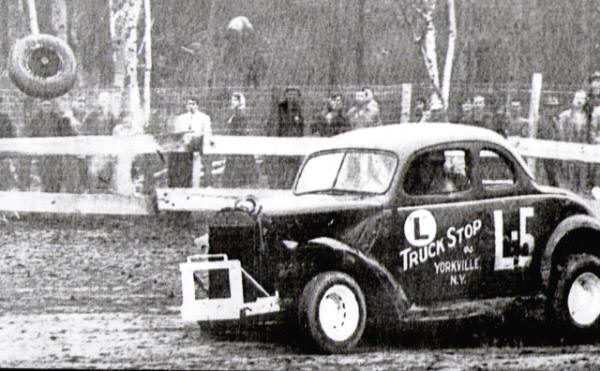
HAMB Site Photo
Hence the nickname “Three
Wheel Mahoney”. Below - Chuck was
thought of well enough to land a Grand National ride.
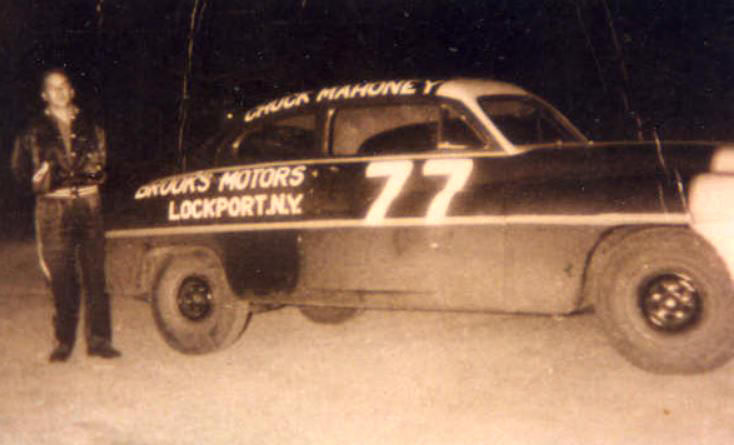
Courtesy of Midstate Club
An exasperated Decar finally yelled something to the effect of “For Crissakes, Chuck, will ya stop[ racin' that poor engine ?”\
Mahoney smirked and replied [while not changing his demeanor a bit] “Well, Fred, ain't this a RACIN' engine ?”
My favorite Mahoney story involves a time when he was running for another well – financed team – the Peter Hollebrand 53. They were at the big Syracuse race at season's end. If you are familiar, the Syracuse race became the Daytona 500 of northeastern modified racing and everyone who was anyone was there with their best stuff. Wes Moody recalls that Mahoney was ahead in the feature by so much that he decided to pit and get a drink of water.
This was fine except that, one the way back out onto the track – he clipped the gate at the entrance to the track from the pits and tore the tire off the rim. I can't imagine this went over big with the Hollebrand group. In fact, they may have even tired of Chuck after that. Mahoney would bounce around a bit longer while Hollebrand went on to be associated with the successful [and far more understated] Jerry Cook.
Courtesy of Joan Swinton Walker
Del Moak, with the Albany
– based roadster Deep 6. This was the
royalty of roadsters, with the motor having been done by Cliff Wright.
According to lore. This is at Champlain Speedway, Ticonderoga.
Below – Buzz Hackel, patriarch of the four generation racing
family, at speed at Burden Lake.
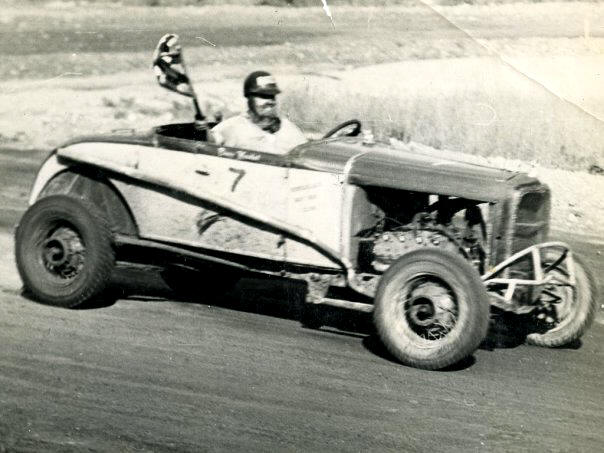
Hackel Family Photo
Another thing I can't see happening in this day and age was roadster racing. In places including California, the Midwest, and in Upstate New York, pre – stock car racing involved jalopies more properly called roadsters. These were usually Model T cars, with no roofs, fenders, hoods and so forth. But what's worse, they featured some serious motors while mostly not featuring roll cages, roll bars, or even helmets and seat belts.
New York roadster racing was going strong in places like Seneca Falls, Warrensurgh, Perth, Ticonderoga, Burden Lake, and other venues. The state produced one really good driver named Art Pratt, from Corinth. When Art was “called up” to race more professional open wheel cars in the Midwest and California, his mechanic took over the Pratt roadster and was soon killed in a widely – publicized incident.
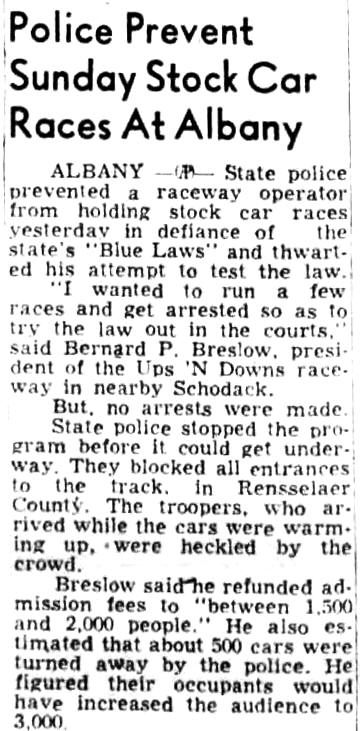
Courtesy of Dan Ody
A typical newspaper
article from the great Blue Laws crackdown
of the early 1950's. Below – Al Moses plies the McGregor Speedway
with a roadster that at least had a roll hoop of sorts. That track
was one that tried defying the Blue Laws and got squashed.
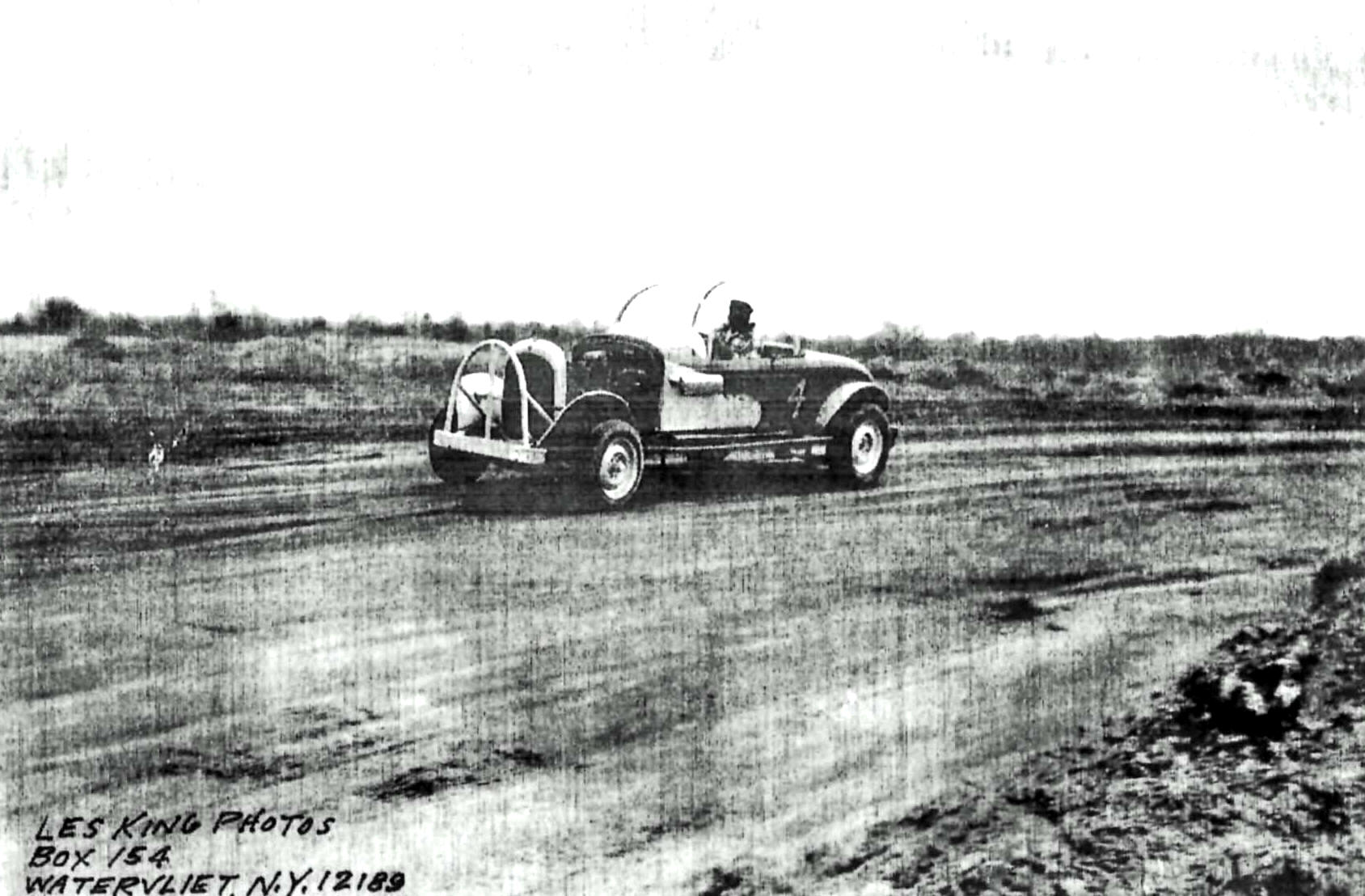
Courtesy of Gail Moses Remington
Then all hell broke loose. The New York legislature and the states attorneys' offices combined with the NY State Police to shut down any track running the roofless death traps. A few tracks like the McGregor Speedway near Saratoga, tried defying the ban and were summarily squashed. By 1952, there was essentially no track running roadsters. Tracks like Warrensurgh, Burden Lake, and a few more went right on to stock cars; others, like Champlain Speedway in Ticonderogas did not survive the change.
Finally, just generally the half -assed way many tracks were run in the early days simply would never hold water today. East Corinth, VT had guys racing with on ly a horse harness to hold them in the car; the Je-Jo-Clin track in Boltonville near the New Hampshire border had cars flying around a track with huge piles of brush practically on the racing surface. Some tracks in Quebec would allow men [sometimes still in their suits from church] racing the family car out with the regular racers.
Courtesy of Scott Haskell
A boy scrambles as a stock
car hits the heavy brush left by the
side of the track at Ge-Jo-Clin Speedway in eastern Vermont.
Below – Cars run at Ray Nadeau's Speedway, Webster Flats,
near Lyndonville, VT. No fence, no bleachers, no nothin'.
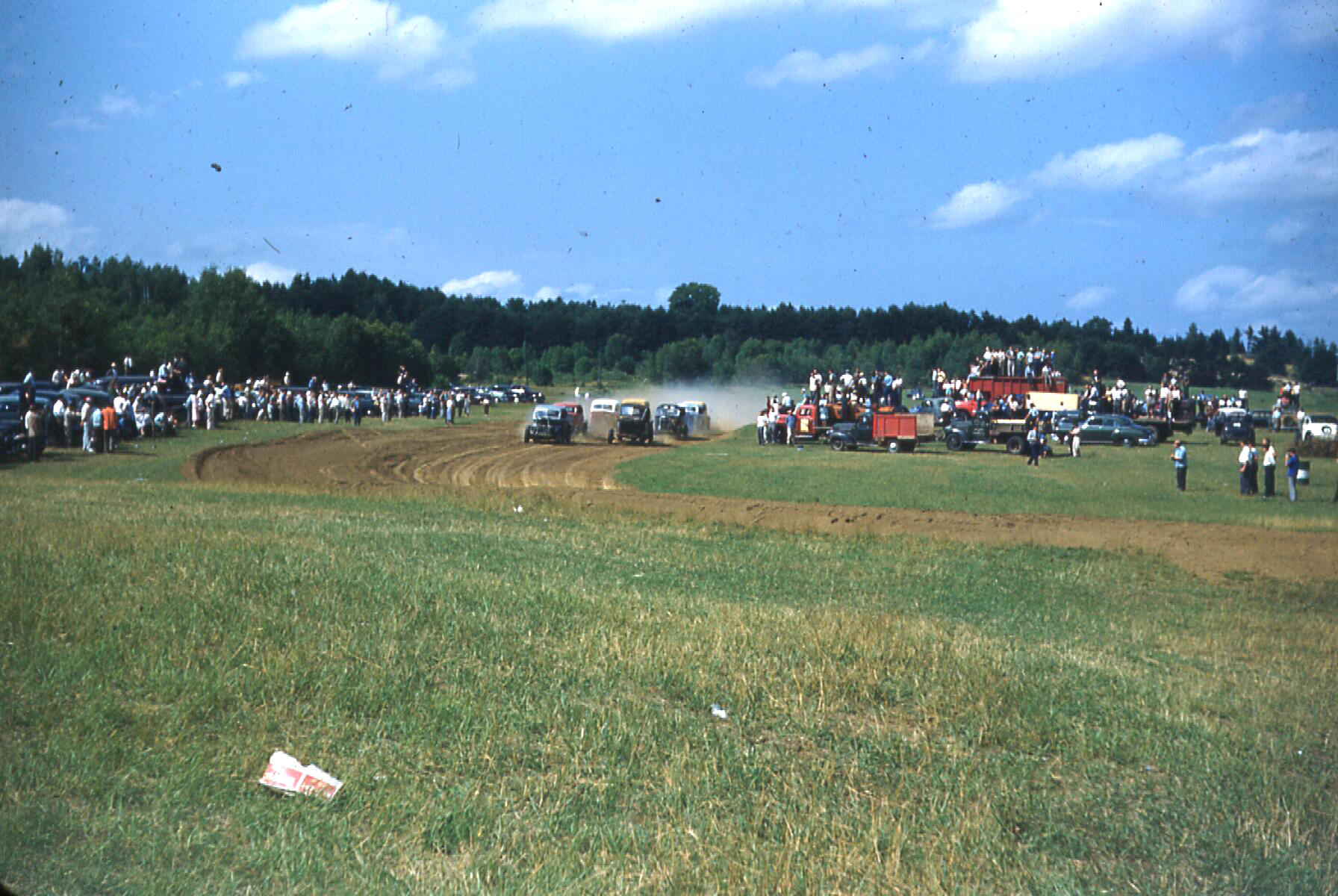
Courtesy of the Bigleow Family
Ray Nadeaus' Speedway at Webster Flats near Lyndonville, VT had spectators standing right beside the racing surface, without the slightest hint of a retaining fence. Otter Creek Speedway, a NASCAR -sanctioned track in Vermont that happened to be a favorite of Ken Shoemaker, featured a fourth turn with a stream of water continuously running across it. That condition is said to be the cause of the demise of Henry Caputo's #11 Plymouth coupe, when George Baumgardner face planted it in that treacherous turn.
Racing, while safer and definitely prettier than the old days, is certainly not more fun to watch [or possibly even to participate in]. It is probably, then, no coincidence that there are precious few race tracks [at least in my neck of the woods] that are on solid financial ground. Can't be helped; the times demand the restrictions.
Bob Mackey Photo via John Rock
Cars fly through the area
where the water often ran across the
Otter Creek Speedway. Can't see it here. Below - George
Baumgardner, an Otter Creek regular with the Caputo
team Plymouth in happier moments.
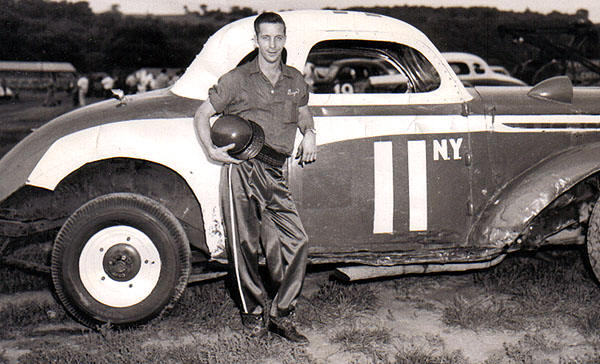
Please email me at wladabou@comcast.net if you have any photos to lend me or information and corrections I could benefit from. Please do not submit anything you are not willing to allow me to use on my website - and thanks. For those who still don’t like computers - my regular address is: Bill Ladabouche, 23 York Street, Swanton, Vermont 05488.
AS ALWAYS, DON’T FORGET TO CHECK OUT THE
REST OF MY WEBSITE:
www.catamountstadium.com
Return to the Main Page
Return to the Main News Page
Return to the All Links Page
Return to the Weekly Blog Links Page